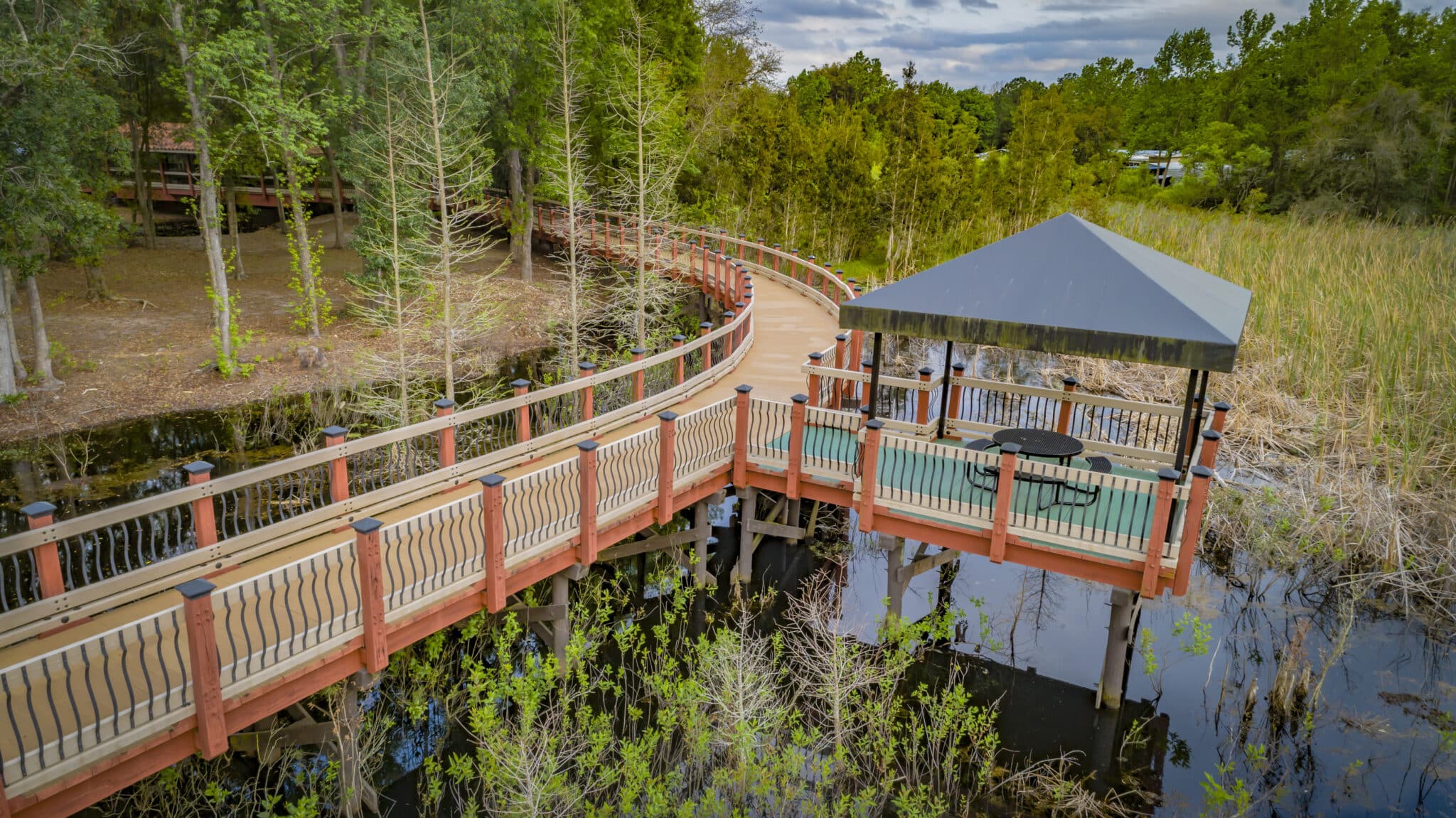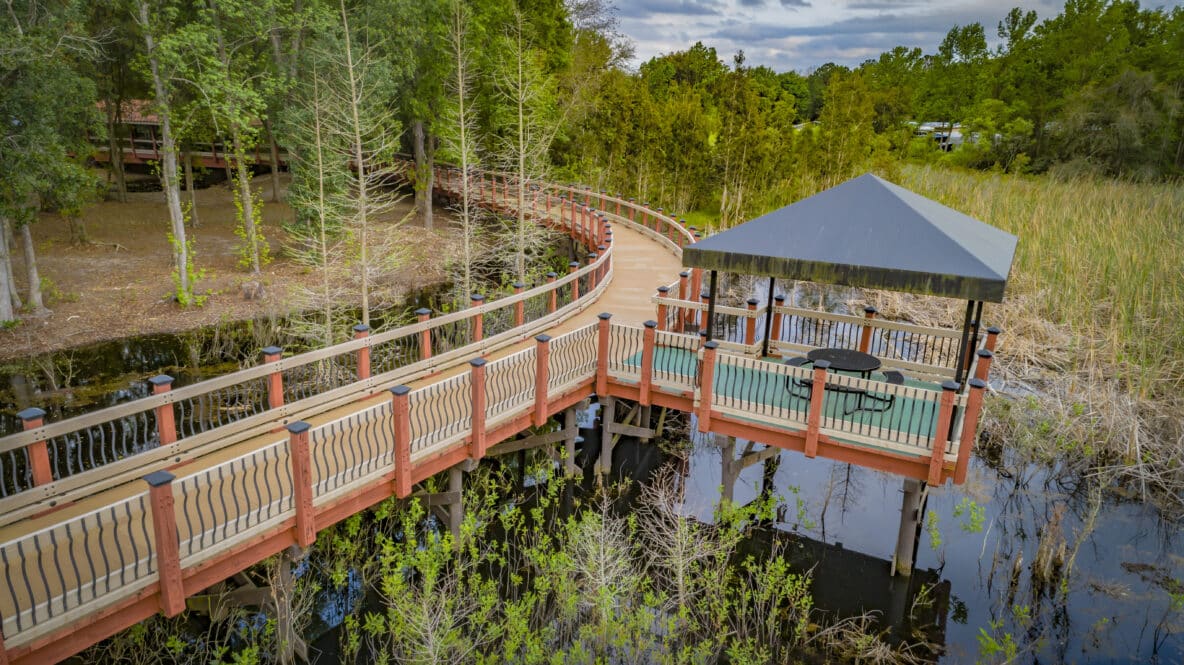
Wetland Conservation with Timber Bridges & Boardwalks
Wetlands are among the most ecologically important and sensitive environments on earth. Wetlands provide an essential ecosystem that services items such as water filtration, flood control, and habitat for diverse wildlife. However, infrastructure development in these areas can pose significant risks, disrupting ecological balances. Timber bridges and boardwalks present a sustainable solution, offering both accessibility and environmental preservation of these precious resources.
York Bridge Concepts (YBC) specializes in timber bridge and boardwalk construction, employing innovative techniques like our Deck-Level (top-down) construction methods to minimize ecological impact. This article explores how timber bridges and boardwalks contribute to wetland conservation, highlighting YBC's expertise in delivering low-impact, environmentally responsible infrastructure.
Understanding the Ecological Importance of Wetlands
Wetlands serve as natural buffers against flooding, act as carbon sinks, and support a rich biodiversity of plant and animal species. According to the U.S. Environmental Protection Agency (EPA), wetlands provide benefits such as:
- Water purification by filtering out pollutants and sediments (EPA, 2021).
- Flood mitigation by absorbing excess rainwater and storm surges with flood plains (USGS, 2020).
- Habitat preservation for species like migratory birds, amphibians, and fish (USFWS, 2022).
- Climate regulation by storing large amounts of carbon (Ramsar Convention Secretariat, 2018).
Despite their importance, wetlands face threats from urban expansion, pollution, and poorly planned infrastructure. Sustainable construction solutions, including timber bridges and boardwalks, can help protect these fragile ecosystems while ensuring access for conservation, education, and recreation.
Challenges of Building Infrastructure in Wetlands
Developing infrastructure in wetlands presents unique challenges, including:
- Soft, unstable soils that make traditional construction methods difficult (USDA Forest Service, 2019).
- Limited access to sites, often requiring innovative construction techniques, like YBC's Deck-Level construction methods (National Park Service, 2021).
- Strict environmental regulations under laws such as the North American Wetlands Conservation Act (NAWCA) and the Clean Water Act (USFWS,2022).
- Flooding risks that demand resilient and adaptive designs (FEMA, 2021).
Traditional concrete or steel bridge construction often requires extensive excavation, heavy machinery, and prolonged site disturbances, leading to habitat destruction. Timber bridges, particularly those built using YBC's deck-level construction method, offer a more sustainable alternative.
Timber Bridges: A sustainable Solution for Wetland Access
Timber bridges and boardwalks offer numerous environmental and structural advantages when constructed properly:
- Lightweight yet strong: Timber's lower density reduces soil compression, making it ideal for soft wetland grounds (American Wood Council, 2020).
- Minimal disturbance: YBC's timber components allow for rapid installation, reducing time and footprint on sensitive sites (USDA, 2019).
- Aesthetic and natural integration: Timber blends seamlessly into wetland environments, maintaining the natural beauty of these ecosystems (National Park Service, 2021).
- Long-term sustainability: Properly treated timber is highly durable and requires less energy to produce than steel or concrete, reducing overall carbon emissions. (USDA Forest Service, 2020).
YBC's Top-Down Construction: A Game-Changer in Wetland Conservation
York Bridge Concepts employs deck-level (top-down) construction, a method that minimizes ground disturbance and preserves the integrity of wetland ecosystems. This approach:
- Eliminates the need for temporary access roads that can damage vegetation and wildlife habitats (EPA, 2021).
- Uses lightweight machinery positioned on completed sections of the bridge, avoiding unnecessary soil disruption (USFWS, 2022).
- Reduces construction time, minimizing human impact and accelerating ecosystem recovery (USFWS, 2022).
- Ensures compliance with wetland protection laws, such as NAWCA and U.S. Army Corps of Engineers Section 404 permitting (USACE, 2021).
This method has been successfully implemented in projects like Coastal Club project in Lewes, Delaware, where YBC constructed a 190-foot vehicular bridge with an attached pedestrian section to connect access to the Phase II development for the community.
Case Study: Mandalay
One example of YBC's commitment to wetland conservation is the Mandalay Timber Vehicular Bridge Project in South Florida. This project included:
- The construction of a timber vehicular bridge to enhance accessibility to a private island while preserving native wetland vegetation and ecosystems (Memorial Park Conservancy, 2022).
- The use of environmentally responsible timber, coatings and pile wraps to prevent leaching into water sources (EPA, 2021).
- Coordination with local environmental agencies, and third party environmental monitoring agencies ensured compliance with wetland protection regulations (USFWS, 2022).
The result was a sustainable, aesthetically pleasing structure that allows access and for residents and visitors to experience the wetlands while minimizing harm to the natural ecosystem.
Regulatory Compliance: Meeting the Requirements of NAWCA & Wetland Protection Laws
The North American Wetlands Conservation Act (NAWCA) plays a critical role in funding and supporting projects that protect and restore wetlands across the United States. NAWCA aligns with YBC's commitment to sustainability by encouraging environmentally sensitive construction practices. Key aspects of compliance include:
- Avoiding unnecessary land disturbances by utilizing existing topography and natural features (USFWS, 2022).
- Using sustainable timber sourcing to ensure responsible material procurement (American Wood Council, 2021).
- Implementing mitigation measures such as elevated decking to allow for water movement and animal passage (EPA, 2021).
Additionally, YBC adheres to U.S. Army Corps of Engineers (USACE) Section 404 permits, which regulate dredging and filling activities in wetlands. These efforts ensure that timber bridges and boardwalks contribute to conservation rather than degradation.
The Future of Timber Bridges in Wetland Conservation
With increasing awareness of the importance of wetland preservation, the demand for low-impact, eco-friendly infrastructure will continue to rise. Timber bridges and boardwalks represent a practical and sustainable solution, especially when built using innovative techniques like YBC's top-down construction.
Future trends in wetland infrastructure include:
- Advanced timber treatments to enhance durability without harmful chemicals (USDA, 2020).
- Integration of renewable energy solutions, such as solar-powered lighting on wetland boardwalks (DOE, 2021).
- Stronger partnerships with conservation agencies to develop infrastructure that aligns with long-term ecological goals (USFWs, 2022).
Wetlands are invaluable ecosystems that require thoughtful and sustainable infrastructure solutions. Timber bridges and boardwalks, especially those built by York Bridge Concepts, provide a way to balance access with conservation. Through top-down construction methods, adherence to environmental regulations, and a commitment to sustainability, YBC continues to lead the industry in wetland-friendly infrastructure development.
By prioritizing environmentally responsible practices, timber bridge construction can play a crucial role in preserving wetlands for future generations while still meeting the needs of communities, land developers, and conservationists.
American Wood Council. (2020). Retrieved from https://www.awc.org/
Environmental Protection Agency (EPA). (2021). Why are wetlands important? Retrieved from https://www.epa.gov/wetlands/why-are-wetlands-important
Federal Emergency Management Agency (FEMA). (2021). Floodplain management. Retrieved from https://www.fema.gov/floodplain-management
Memorial Park Conservancy. (2022). Retrieved from https://www.memorialparkconservancy.org/
National Park Service. (2021). Sustainable trails & boardwalks. Retrieved from https://www.nps.gov/subjects/trails/index.htm
North American Wetlands Conservation Act (NAWCA). (2022). Retrieved from https://www.fws.gov/program/north-american-wetlands-conservation-act
Ramsar Convention Secretariat. (2018). Retrieved from https://www.ramsar.org/
United States Army Corps of Engineers (USACE). (2021). Section 404 wetland permitting. Retrieved from https://www.usace.army.mil/
United States Department of Agriculture (USDA) Forest Service. (2019). Wetland management. Retrieved from https://www.fs.fed.us/biology/wetlands/
United States Geological Survey (USGS). (2020). Wetlands. Retrieved from https://www.usgs.gov/special-topics/water-science-school/science/wetlands
United States Fish and Wildlife Service (USFWS). (2022). North American Wetlands Conservation Act. Retrieved from https://www.fws.gov/program/north-american-wetlands-conservation-act

